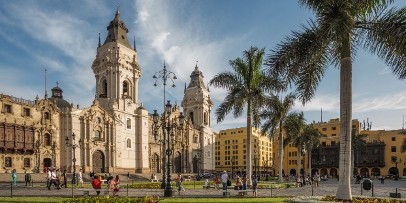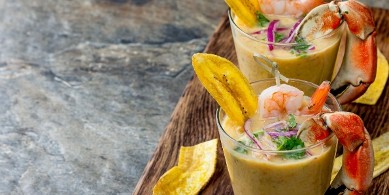Lima, the capital of Peru, is a city of contrasts. On the hills surrounding the city center of this eleven-million-strong metropolis, you’ll find neighborhoods struggling with poverty. In the colonial heart of the city, countless churches and palaces gleam with genuine gold. However, there’s also a growing middle class enjoying themselves in sparkling districts, trendy bars, and restaurants, as well as the suburbs perched on the cliffs overlooking the Pacific Ocean. While many reports about Peru, especially Lima, still focus on the wealth gap, the local reality is much more nuanced.

Lima has become cosmopolitan, and its splendor can be seen in many places. The culinary scene is as vast and ambitious as that of the world’s mega-cities. Food enthusiasts from all over the region come to the city, its upscale neighborhoods, and beachfront promenades to visit top restaurants like Maido and Huaca Pucllana. Just like the culinary scene, the art scene also attracts people from afar. Magnificent exhibitions showcase ancient indigenous treasures, while contemporary and experimental art is on display in an increasing number of galleries.

In fact, Lima boasts numerous outstanding collections. Among the most notable is the Archaeological Museum (Museo Larco), just a fifteen-minute walk from the city center, serving as a gateway to the ancient American cultures of the entire Andean region. At the Gold and Weapons Museum (Museo Oro del Perú y Armas del Mundo), precious metals and jewelry glisten everywhere you look.

With its glass cubes, the Museum of Modern Art (LiMAC, Museo de Arte Contemporáneo de Lima) in the bohemian Barranco district offers an eye-catching contrast to the historically significant exhibitions of ancient American cultures. The LiMAC’s cafeteria also provides a pleasant oasis in the city’s hustle and bustle and serves as an ideal place to connect with art enthusiasts from Peru.

Lima is not short of noteworthy churches either. Hundreds of impressive Catholic churches rise from the urban sprawl of the metropolis. The history of the Cathedral at the central Plaza Mayor, dedicated to the Apostle John, dates back to 1535, and shortly thereafter, the San Francisco Monastery was founded. Nestled in the UNESCO-listed historic center, the Basilica San Pedro, built in 1638 in pure Neoclassical style by Jesuits, stands as the best-preserved religious structure from the time of the Spanish Conquistadores. To this day, it is managed by the Jesuit order along with the adjacent monastery.
In contrast, the Temple of the Sacred Heart of Mary, dedicated to the heart of Mary, is relatively young, at just around 80 years old. The green-domed structure is the tallest church in the city, with a fiberglass and resin statue of Mary shining atop its 70-meter pinnacle. The residents of the pleasantly tranquil and coastal middle-class neighborhood of Magdalena del Mar hold a deep affection for this church precisely because it doesn’t exude the opulence seen in the lavishly adorned religious buildings from Lima’s founding era, neither from the outside nor within.
The historic old town, which has been under the protection of UNESCO as a World Heritage Site for 30 years, is a cause for concern among officials. Emissions from car traffic and other sources are deteriorating the centuries-old buildings. Limeños, the residents, escape the traffic gridlock and poor air quality on weekends by relaxing in numerous parks (such as Parque de la Exposición in the Santa Beatriz district) and the nearby beaches, easily accessible by bus.

In the seaside suburbs around Lima, there is a laid-back vacation atmosphere with plenty of restaurants, bars, and nightclubs. Punta Hermosa, in particular, stands out as a hotspot for surfers from all over the world and is renowned for its top-notch seafood eateries along the waterfront. Another popular and easily reachable destination is the Boulevard de Asia, located at kilometer 98 on the Panamericana Sur (which means it’s 98 kilometers south of downtown Lima). Especially on weekends, this area buzzes with a fantastic party vibe in numerous entertainment venues.

And where does all of Lima gather? Again and again, you’ll find them in trendy neighborhoods like Barranco (known for its street art, numerous galleries, and unique pubs), Miraflores, and San Isidro. Lately, Lima’s center is also making a colorful comeback. The historic Chinatown around Calle Capón has entered the scene with some ambitious restaurants. The debate over whether the best Pisco Sour (a cocktail made with grape brandy) is in Chile or Peru rages on in both countries like a religious war – but the unbeatable version of this drink can be found at the very British-themed Bar Inglés in San Isidro’s Country Club Hotel.

A true legend in Lima is Bar Cordano, where the action never stops. Every chair is occupied, a dozen waiters tirelessly serve coffee, and trays filled with Pisco Sour glasses. At some tables, elderly gentlemen have been sipping red wine and sharing veteran stories for hours. This is where they used to gather, drink, and verbally change the world: Alberto Sanchez, Alfredo Gonzales Prada, Nobel laureate Mario Vargas Llosa, and even the political elite, who resided diagonally across the street, refreshed themselves and felt at ease for many years.
As we come to the end of our journey through Lima, I hope that you have gained a newfound appreciation for all that this city has to offer. From the stunning architecture to the mouth-watering cuisine, Lima truly is a gem of South America. And, if you’re hungry for more, be sure to check out this story, where you can read about the top 8 must-see highlights in Lima. Until then, safe travels!




